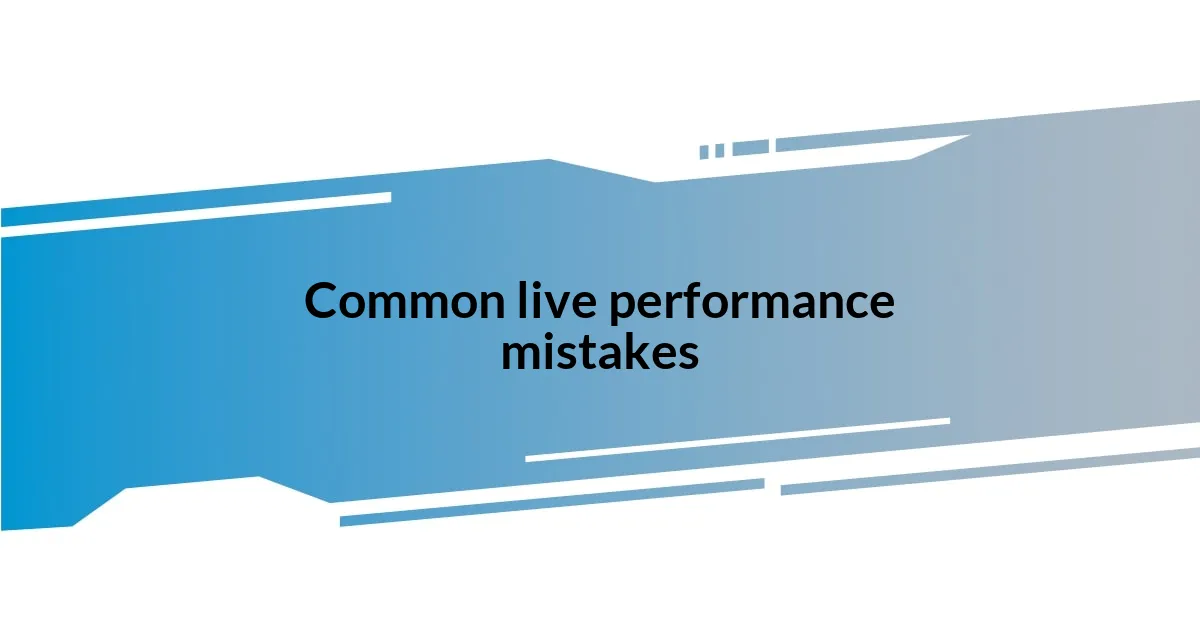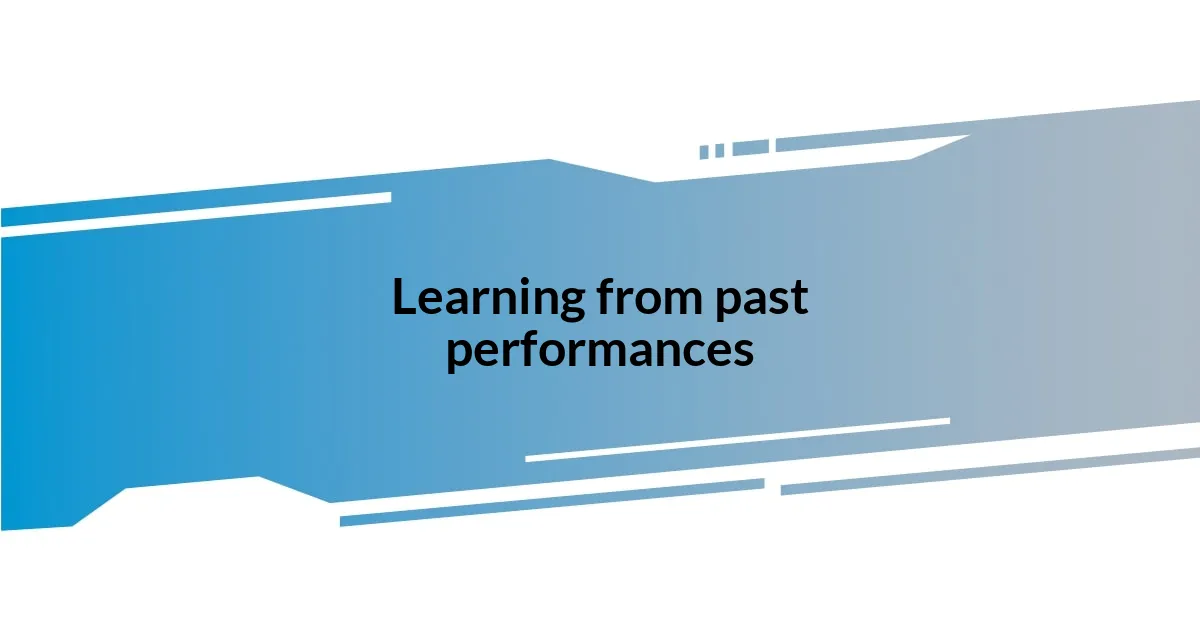Key takeaways:
- Performance anxiety can motivate and energize performers if harnessed effectively, transforming fear into creativity.
- Common mistakes include forgetting lyrics, lack of audience engagement, and unpreparedness for technical issues; embracing these can enhance the performance.
- Preparation techniques like regular practice and mock performances significantly reduce errors and boost confidence before going on stage.
- Reflecting on past performances helps artists learn from mishaps, embrace vulnerability, and build confidence for future shows.

Understanding performance anxiety
Performance anxiety is something that many of us face, often manifesting as a mix of nervousness and fear of judgment. I remember my first live performance; I was shaking so much that I thought I might drop my instrument. Have you ever felt your heart racing and your palms sweating before stepping on stage? That feeling can occasionally be overwhelming, making it challenging to focus.
What’s fascinating is how performance anxiety can be both a hurdle and a motivator. Sometimes, I channel that adrenaline into my performance, turning what could be crippling anxiety into a driving force that enhances my energy on stage. Isn’t it interesting how the same feelings that threaten to paralyze us can also propel us to greater heights when we learn to harness them?
Understanding the underlying emotions of performance anxiety is crucial for managing it. I’ve often found that being aware of my feelings helps me unpack them on a deeper level. Why do we fear judgment from an audience? For me, it boils down to a desire for connection and validation, but acknowledging that fear allows me to approach live performance with a new perspective.

Common live performance mistakes
One common live performance mistake that many artists make is forgetting lyrics or notes mid-performance. I remember during one of my gigs, I completely blanked on the chorus of my favorite song. It felt like time stopped, and I could see the confusion on the audience’s faces. In those moments, embracing the mistake rather than panicking can turn an awkward silence into a chance for creativity. After all, audience members often appreciate authenticity more than perfection.
Another mistake is failing to engage with the audience. I’ve seen performers get so caught up in their set that they neglect to make eye contact or interact with listeners. I learned early on that a genuine smile or a quick story can bridge the gap between performer and audience. Imagine how rewarding it feels to share that connection; it’s almost like inviting them into your world for a few minutes.
Lastly, not being prepared for technical issues can lead to distress during a live show. I recall a time when my microphone cut out unexpectedly. Instead of panicking, I chose to keep singing and relied on the crowd to fill the silence. This not only handled the situation but also created a memorable moment that bonded us all. Every mistake is a potential opportunity to enhance the performance and keep the audience engaged.
| Common Mistakes | Personal Insight |
|---|---|
| Forgetting lyrics or notes | Turning an awkward silence into creative spontaneity can enhance the performance. |
| Lack of audience engagement | Interaction builds a genuine connection, making the audience feel part of the experience. |
| Unprepared for technical issues | Embracing unexpected moments can transform challenges into memorable experiences. |

Preparation techniques to avoid mistakes
Preparation is key to reducing live performance mistakes. In my experience, I’ve found that thorough preparation can significantly boost confidence and minimize errors. When I put in the effort to practice consistently and rehearse thoroughly, I feel more equipped to handle unexpected challenges on stage. I’ve noticed that even small rehearsals, like running through my setlist just before the performance, can make a huge difference in how I feel once I step on stage.
Here are some effective preparation techniques I’ve adopted:
- Regular Practice: Consistency in playing and singing ensures muscle memory is strong, reducing slip-ups.
- Mock Performances: Setting up informal shows for friends or family can help simulate the live atmosphere.
- Visualization Techniques: I often visualize a successful performance, which helps alleviate anxiety and boosts my confidence.
- Know Your Equipment: Familiarizing myself with my gear prevents technical hitches that could disrupt the flow.
- Set List Familiarity: Having a well-structured and practiced set list allows me to navigate smoothly, even if I get somewhat distracted.
When I look back at my journey, embracing these preparation techniques not only lessened mistakes but also transformed my approach to live performances. It’s quite empowering to step on stage knowing I’ve armed myself with the tools to handle the unexpected.

Developing a quick recovery plan
Developing a quick recovery plan is essential when mistakes happen on stage. I’ve learned that having a few go-to strategies can make all the difference. For instance, when I mistakenly missed a chord while performing, I quickly shifted into a spontaneous solo. Not only did this allow me to regain my composure, but it also energized the crowd, turning a blunder into an unexpected highlight.
One important component of my recovery plan is staying in tune with the audience’s energy. I often ask myself, “How can I reconnect with them?” If I notice a dip in engagement due to a mistake, a simple, light-hearted joke can help diffuse the tension. I still remember a night when I tripped over a speaker—the whole place erupted in laughter. Instead of feeling embarrassed, I turned it into a playful moment, arms raised like I had just completed a daring stunt. It’s incredible how humor can mend the gap between performer and audience.
Additionally, I find it advantageous to rely on my bandmates during unpredictable moments. There’s a level of trust that comes from rehearsing together, and knowing they’ve got my back gives me a sense of security. Once, during a performance, my guitar went out of tune, and instead of panicking, I locked eyes with my guitarist, and we quickly shifted to an impromptu harmonization that felt like a secret between us and the audience. This camaraderie not only helped me recover but added an authentic touch to our performance that night.

Maintaining audience engagement after mistakes
Maintaining audience engagement after a mistake can feel daunting, but I believe it’s all about creating a genuine connection. Once, during a particularly upbeat song, I lost my place completely. Rather than forcing my way back, I took a moment to make eye contact with the audience and shared a quick laugh about my “creative interlude.” It was amazing how this simple moment shifted the energy, reminding both me and the crowd that we’re all in this together.
Another strategy I’ve found effective is to turn mistakes into interactive experiences. When I fumbled a couple of lyrics during a popular chorus, I playfully encouraged the audience to sing along, making them feel like co-stars in the performance. That act of inviting participation transformed an awkward moment into a shared joy. Have you ever noticed how audiences love being included? It’s rewarding to see them light up when they feel a part of the show.
Ultimately, patience is key. I remember a performance where I accidentally spilled my drink right before a heartfelt song. Instead of panicking, I took a deep breath and shared a quick story about how I’m always more nervous when ticking off my caffeine intake! Just allowing myself to pause, relate, and pivot helped the audience connect on a personal level. It reminded me that embracing my imperfections can be a powerful way to strengthen the bond with those watching.

Learning from past performances
Reflecting on past performances has become a crucial part of my growth as an artist. I remember one particular gig where the sound system malfunctioned right at the climax of a song. It felt like my heart dropped, but afterward, I sat down with my setlist and seriously evaluated what went wrong. Not surprisingly, I discovered that we hadn’t properly checked the equipment beforehand. This oversight taught me the importance of sound checks and the need for backup plans.
I’ve also learned to analyze my emotions during these mishaps. After a flubbed solo, I used to feel overwhelmed by embarrassment. But looking back, I realized it was more about recognizing how I let that affect my performance. There was a show where I lost my footing during a high-energy number and fell. Instead of letting it ruin my set, I started to think about how I could turn that nervous energy into something positive. Since then, I’ve made it a point to channel any anxiety into playful interactions with the audience.
One of the best lessons I’ve derived from reflecting on my performances is how to embrace vulnerability. When I recall an embarrassing moment, like missing a key change, I use it as a reminder that everyone makes mistakes. I think, “What would I tell a friend in a similar situation?” The answer is always to be kind to oneself. This mindset shift has allowed me to transform potential embarrassment into a relatable experience, reinforcing the connection with my audience. Have you ever found comfort in shared experiences, even when they didn’t go as planned? I’m sure you have!

Building confidence for future shows
Building confidence for future shows is something I approach from a deeply personal angle. After a particularly challenging performance where I blanked on a crucial verse, I made a promise to myself: I would visualize success before stepping on stage. Picture this: I’d close my eyes and imagine each note flowing perfectly, the audience cheering. This mental rehearsal not only calmed my nerves but also instilled a sense of readiness. Have you ever tailored your visualization to include the supportive faces in the crowd? It’s remarkable what a little positive imagery can do!
Another method that has worked wonders for me is setting small, achievable goals for each performance. For instance, I might focus on nailing just one song completely or interacting with the audience a bit more during the show. After one gig where I felt unsteady and unsure, I broke down what I wanted to work on right after, such as making eye contact with more fans or finding ways to add spontaneous moments. By doing this, I was able to track my progress and celebrate those little victories. Doesn’t it feel incredible to acknowledge personal growth, even in small doses?
I’ve also found that surrounding myself with supportive peers has been vital in boosting my confidence. After a show where I felt I wobbled through half my set, I reached out to fellow musicians. We shared our experiences, laughs, and mistakes, which made me realize I wasn’t alone in feeling this way. It dawned on me that vulnerability isn’t a sign of weakness but rather a bridge to deeper connections. How about you? Have you tapped into the power of camaraderie to enhance your performance confidence? It’s amazing how sharing our journeys can uplift us for future shows.